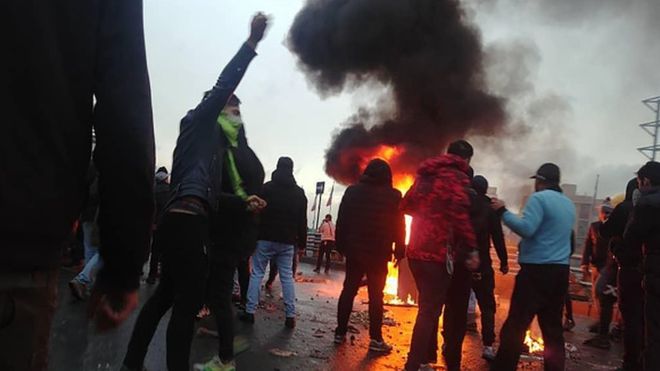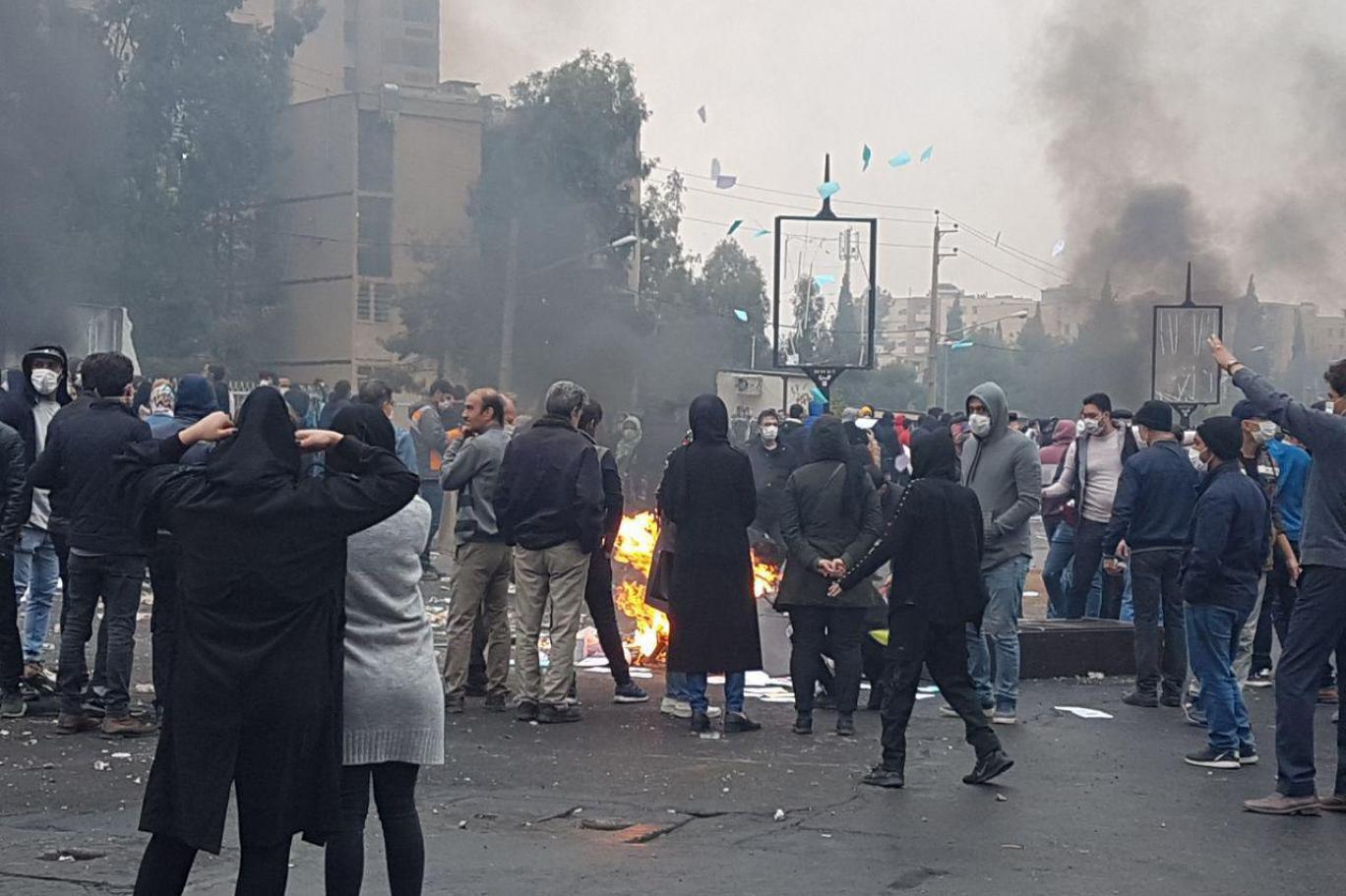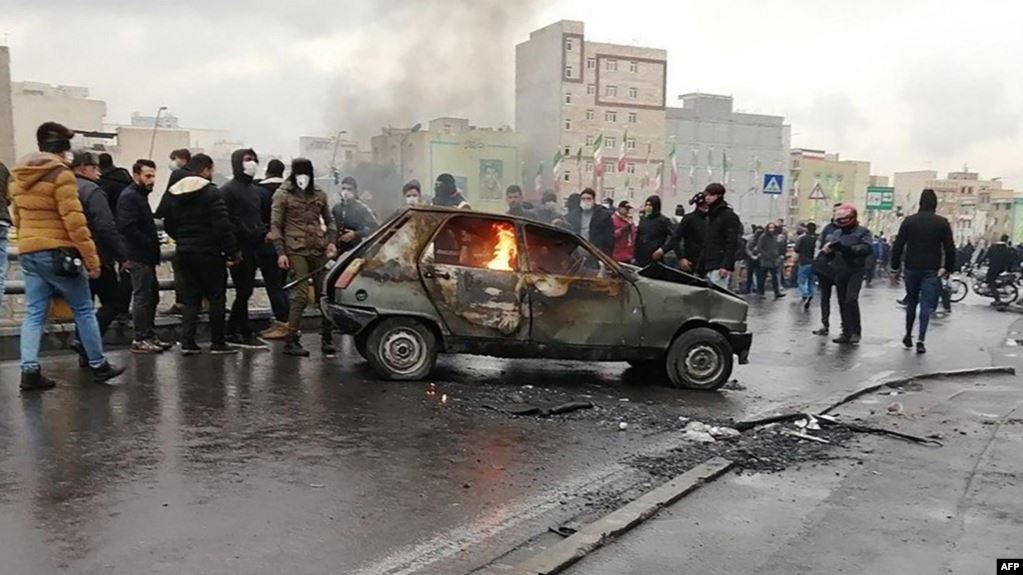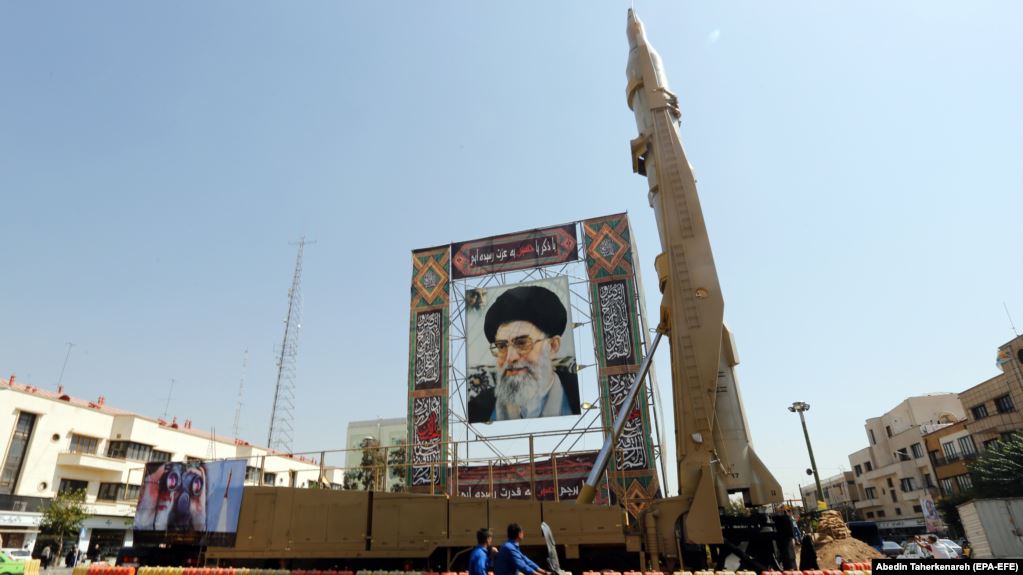![]()
Motives and Consequences of hiking the price of fuel
Despite the efforts of the previous government to increase the price of fuel, the measure was not ratified in the 2018 budget due to concerns over an increase in inflation. The Supreme Council of Economic Coordination, led by the heads of the three branches of government, sidestepped the parliament and decided to increase the price of fuel.
Many economic reasons have been mentioned to justify the decision such as reducing the budget deficit, not giving subsidies to the rich, environmental issues, and preventing smuggling. But it seems that this decision is mainly because of a severe drop in oil revenues due to the US economic sanctions against Iran. Therefore, increasing the price of fuel has been mainly driven by short-term political motives and is ultimately been done to confront US sanctions.
But apart from the Iranian establishment’s motives and will in enforcing this decision, the consequences of this measure are far-reaching.
The first impact of this decision is psychological as producers and suppliers of goods and services will immediately react, and the prices of other goods and services will increase, too. Since the expenses of all goods and services in Iran’s economy depend on the price of fule , the natural expectation is that the price of goods and services will eventually go up.
As a result, hikes in fuel prices will impact the inflation rate in the short-term. Naturally, low-income households are more harmed by such decisions because of a decrease in their purchase power.
Furthermore, such an abrupt and huge increase in fuel prices will create crises for businesses and economic units under the current high inflation rate and US sanctions. This is will lead to a situation where businesses suffer due to a shortage of liquidity, and high prices. This will create further economic crises in the country.
Investment too will be threatened by the increase in fuel prices. Given the problems that will follow, business owners will have doubts regarding investments, as an increase in the price of fuel will put their investments at risk. As a result, the economic recession in Iran will become deeper.
Radio Farda
Features of a riot
The editorial of the IRGC-affiliated Javan newspaper goes over the distinctive features of the recent protests in Iran. Iranian officials and those close to the establishment call what is happening a “riot” and not a popular protest.
Before dealing with the features of the recent riots, three points must be mentioned: during past months, the Iranian government should have justified the increase in the price of fuel, instead of announcing it so unexpectedly. The absolute silence of government officials in this regard is unforgivable, and they should apologize for it.
The second point is paying attention to this “new phenomenon” from psychological and sociological points of view. Hatred is a source of violence. Tehran’s satellite cities were the centers of the riots. Therefore, the conditions of those who commute to Tehran every day to help others enjoy luxury lives, gain a small income and go back home every night must be studied.
Thirdly, all officials express the right of the Iranian people to protest. But there is no legal process to formalize protests in the country. If the establishment insists on distinguishing between protests and riots, it must at least prepare the legal grounds for it.
As for the recent riots, they have unique features that make them distinct from mere protests. There were protesters whose voice was lost in the riots, and what is important is the absence of the middle class.
1. “Organized violence” – with unprecedented depth and level – was one of the features of the recent riots. The level of sabotage and the high number of human casualties indicates this.
2. In these riots, there were no large crowds, which shows a lack of popular support for them.
3. They didn’t have any particular demands. What could be seen was all-out sabotage.
4. Assailing sensitive centers including military and police bases was one of the features of these protests. The bases belonging to the police, the IRGC, and the Basij were attacked with weapons.
5. The rioters were trained, and they were carrying special tools.
6. Looting public and privately stores was a feature of these riots.
7. The behavior of the rioters nationwide followed the same pattern: violence, no slogans, no demands, and they carried the same tools for sabotage.
8. America’s open support for the riots.
9. The human casualties suffered by Iran’s military and law enforcement forces indicate that the rioters used machetes and firearms.
10. A special role was assigned to women: attacking women’s Basij centers and provoking the young.
Javan
Containing the protests by shutting down the Internet
The editorial of Jahan Sanat explains why the Iranian government has decided to shut down the internet, despite the fact that it harms many online businesses in the country.
The internet is extensively disrupted in Iran. Right now, accessing Google and other necessary applications is impossible in Iran. Almost all online businesses do not have access to the internet, and their businesses are disrupted.
Of course, many websites, applications, and start apps that use domestic servers are not disrupted, which is why many start apps are forced to move to these servers. Online businesses are facing a dilemma: shutting down business or moving to domestic servers – something that most online businesses have to do to avoid being shut down.
It seems however that disrupting the internet has been a suitable way to control the popular protests in Iran. Even though people can use telephones and SMS to coordinate their protests, it becomes easier to track them. Also, they have to contact each other individually to coordinate , whereas they could invite all to a protest by posting an invitation on social media.
The internet being shut down will stop many popular demonstrations and protests, which is why the government has decided to shut down the internet, even if it means great damage to businesses in Iran.
Jahan Sanat
Raising the price of fuel; why now, why like this?
The editorial of Siasat Rooz explains why raising the price of fuel, as well as the way it was announced and handled by the Iranian government, was wrong.
With a statement issued in the early hours of Friday morning, the National Oil Products Distribution Company announced that, with the ratification of the Supreme Council of Economic Coordination, the price of gas will significantly increase. Rationed gasoline will be offered at 1500 tomans with a 50% increase, and the price of non-rationed gas will triple to 3000 tomans.
Even though there are reasonable economic reasons for amending and increasing the price of fuel , there are fundamental problems with the government’s recent decision in this regard:
1. The way it was announced to people was insulting. Instead of increasing the price so suddenly, the government should have given convincing explanations about the necessity of raising the price of fuel over a long period of time. The government didn’t do that, and in recent weeks, officials even denied any such increase.
2. What is the legal status of the Supreme Council of Economic Coordination – led by the heads of the three branches of government – for making such a decision ? An increase in the price of fuel should have been ratified in the annual budget by the parliament. All heads of the three branches of government must be held accountable for violating the constitution.
3. Have they thought of the security consequences of this decision? When inflation is at 40%, increasing the price of fuel will create widespread discontent in society. When in neighboring countries people have been protesting for about a month over economic conditions, corruption, and inefficiency, was there any security justification to make the people so dissatisfied?
Siasat Rooz
![]()
At least 106 killed in recent protests, says Amnesty International

Amnesty International says that based on verified video footage , eyewitness testimonies, and the information gathered by human rights activists, more than 100 people have been killed in the recent protests against fuel price hikes in Iran. More than 1000 people have been reportedly arrested.
According to the report, since the beginning of protests on November 15, at least 106 people have been killed in 21 cities by security forces. Amnesty International has announced that some unofficial reports indicate that about 200 people have been killed. Iranian authorities have not given any official statistics in this regard.
According to the report, the number of deaths in Khuzestan and Kermanshah provinces are the most with, respectively, 35 and 30 people killed.
Video footages sent from Iran, according to this report, show that security forces have used firearms, water cannons, and tear gas to disperse the protesters. Amnesty International says when the Iranian Supreme Leader Ali Khamenei called the protesters “miscreants”; he gave Iran’s security forces a green light to suppress the protesters.
This organization has asked Iranian officials to respect the freedom of expression and the right to protest peacefully, , calling for all restrictions on the internet to be lifted. It has called the complete shutdown of the internet in Iran as limiting the free flow of information.
Amnesty International has called for immediate measures of the international community including the United Nations and the European Union to hold Iranian officials accountable for carrying out unlawful killings and brutally repressing the right to freedom of expression and peaceful assembly.
BBC Persian
Radio Farda
Questions about the recent protests

To understand the recent protests in Iran against fuel price hikes, the following questions need to be presented and answered:
Why announce the fuel price hikes now?
It has been a year and a half since the US imposed sanctions on Iran. If there is any problem with the budget, why did they decide to raise the price of fuel now? It seems that Iran’s treasury is empty because of the US sanctions. It must be noted that the Supreme Council of Economic Coordination, led by the heads of the three branches of government, wouldn’t have taken this decision without coordinating first with Iran’s supreme leader, as implementing it requires cooperating with Iran’s security forces led by him.
What is the impact of fuel price hikes on the rate of inflation?
Iranian officials have announced that its impact will be 4%. But experience shows that this number is false. Studies show that for each 10% increase in the price of fuel, there will be a 2% increase in the rate of inflation. As such, inflation will increase from 10 to 60 percent.
How widespread are the protests?
The protests have been reported in 14 provinces and tens of cities. During these protests, tens of banks, several government centers including a Basij base, several gas stations, several seminaries, and a number of law enforcement vehicles have been set on fire. The internet has been shut down, and the protests have been taken to the roads.
Who is hurt the most by this decision?
The Iranian Supreme Leader Ali Khamenei has said that those who own five cars would be against fuel price hikes. But the truth is that gasoline in Iran is not a luxury for the rich. The livelihood of the poorest people depends on it, which is why the protests can be seen in both large and small cities. Nowadays the poor are the ones who are mostly damaged by the Iranian regime’s domestic and foreign policies.
What slogans are most frequently heard among the protesters?
“Our enemy is here [the regime], they lie when they say it is America,” “May God bless Reza Shah,” and “Mullahs should get lost”. These three slogans, respectively, are negating the regime’s conspiracy theory, rejecting the basis of the 1979 Revolution, and pointing to the roots of all miseries and humiliations. Interestingly, there are no slogans with religious content.
What will be the outcome of the protests?
The experience of the past 40 years shows that urban protests due to rise in prices will soon end , and the regime will manage to suppress them. As long as there is no gap between the security and military forces, the regime can manage to suppress such protests.
Independent Persian
Repetition of big protests in Iran; why more violent confrontations?

Recent protests in Iran show that the Islamic Republic is now facing the phenomenon of “repetition of big protests”. The interval between big protests has significantly shortened, and now the Islamic Republic is facing a big anti-establishment protest every two years.
Between the 1999 protests (attacking the university campus in Tehran) and the 2009 protests (over rigged presidential election), there was a 10-year interval. But there were only two years between the big, nationwide protests of 2017 and 2019.
The other point is that between the 2017 and 2019 protests, smaller protests continuously took place every month.
While the 1999 and 2009 protests were mostly over disputes between the factions within the Iranian regime [“reformists” and “hardliners”], the big protests of 2017 and 2019 were launched by people who are fed up with the current situation. They took to streets — spontaneously and without having any particular leadership or organization — against the entirety of the Islamic Republic.
Even though the 2017 and 2019 protests were triggered by economic reasons, they immediately turned against the regime and authorities. So these protests can no longer be deemed as merely being against fuel price hikes.
The other point is the brutality of the regime. The recent events show that the Islamic Republic moves very quickly to use firearms as well as to shoot directly at people. It seems that the regime is afraid of losing control inside the country, particularly now that it is facing strong, unprecedented pressures from outside and its oil revenues have been cut off.
The entire regime is determined to crack down on the protests. The Interior Minister has threatened to confront the protesters, while Ali Khamenei called them “miscreants” and demanded Iran’s security officials to confront them.
At The regime’s attempt to show a united front against the protesters indicates that the entire regime is concerned, and this crisis has challenged the totality of the regime.
Radio Farda
Iran has the biggest missile stockpile in the Middle East

The US Defense Intelligence Agency (DIA) published a report, saying that Iran’s missile stockpile is the biggest in the Middle East, even bigger than Israel’s missile stockpile.
According to t this agency, affiliated with the US Defense Ministry, during the past 40 years, the Islamic Republic has developed its missile plan, and despite efforts for years to stop this program, the quality and quantity of these missiles are still increasing.
DIA’s report shows that two years ago the Islamic Republic unveiled a missile with a 2000km range, capable of carrying different warheads. According to this report, North Korea’s
technology has been used in building this missile.
The report adds that in the absence of an advanced air force with the capability of carrying out long-range attacks, Iran has moved towards ballistic missiles.
According to the report, with an increase in military capabilities, Tehran is after achieving two goals: guaranteeing its survival and having the upper hand in the region.
The report urges that if the UN sanctions were not in place against the Islamic Republic, Tehran would have moved faster towards increasing its military capabilities. The UN sanctions are supposed to be lifted in 2020.
Iran’s missile program has been repeatedly criticized by America and its European allies. And Washington has demanded that it should be included in a new round of negotiations with Tehran.
The Islamic Republic hasn’t shown any willingness to negotiate over its missile programs so far. Iranian military officials say that the missile program has a defensive nature while declaring that Iran is in possession of very precise, secret missiles.
The United States and its allies believe that Iran’s ballistic missile program is in defiance of UN Security Council Resolution 2231. The US officials also say that the Islamic Republic equips groups like Lebanese Hezbollah, Palestinian Hamas, and the Yemeni Houthis with missiles, thus destabilizing the region.
Radio Farda
BBC Persian
